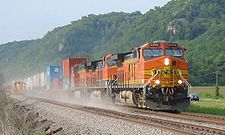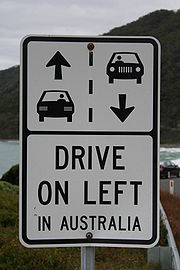
Bidirectional traffic
Encyclopedia
In transportation infrastructure, a bidirectional traffic system divides travelers into two streams of traffic that flow in opposite directions.
Bidirectional traffic is observed in a wide variety of applications, including aerodynamics; architecture; cellular automata; data; engineering; entomology; model theory
; molecular biology; ornithology; pedestrian movement; and statistical mechanics.
s, bidirectional traffic can markedly affect ventilation
considerations.
s have been proposed for bidirectional automobile, pedestrian, and railway traffic.
trails. As of recent years, this behavior has been researched for insight into human traffic models.
 In the earliest days of railways in the United Kingdom
In the earliest days of railways in the United Kingdom
, most lines were built double track
ed because of the difficulty of coordinating operations in pre-telegraphy
times.
 Most modern road
Most modern road
s carry bidirectional traffic, although one-way
streets are common in dense urban centres.
Bidirectional traffic flow is believed to influence the rate of traffic collisions. In an analysis of head-on collision
s, rear-end collision
s, and lane-changing collisions based on the Simon-Gutowitz bidirectional traffic model, Moussa concluded that "the risk of collisions is important when the density of cars in one lane is small and that of the other lane is high enough", and that "heavy vehicles cause an important reduction of traffic flow on the home lane and provoke an increase of the risk of car accident".
In a macroscopic theory proposed by Laval, the interaction between fast and slow vehicles conforms to the Newell kinematic wave model of moving bottleneck
s.
Bidirectional traffic is observed in a wide variety of applications, including aerodynamics; architecture; cellular automata; data; engineering; entomology; model theory
Model theory
In mathematics, model theory is the study of mathematical structures using tools from mathematical logic....
; molecular biology; ornithology; pedestrian movement; and statistical mechanics.
Aerodynamics
In the design and construction of tunnelTunnel
A tunnel is an underground passageway, completely enclosed except for openings for egress, commonly at each end.A tunnel may be for foot or vehicular road traffic, for rail traffic, or for a canal. Some tunnels are aqueducts to supply water for consumption or for hydroelectric stations or are sewers...
s, bidirectional traffic can markedly affect ventilation
Ventilation (architecture)
Ventilating is the process of "changing" or replacing air in any space to provide high indoor air quality...
considerations.
Modeling
Microscopic traffic flow modelMicroscopic traffic flow model
Microscopic traffic flow models are a class of scientific models of vehicular traffic dynamics.In contrast to macroscopic models, microscopic traffic flow models simulate single vehicle-driver units, thus the dynamic variables of the models represent microscopic properties like the position and...
s have been proposed for bidirectional automobile, pedestrian, and railway traffic.
Entomology
Bidirectional traffic can be observed in antAnt
Ants are social insects of the family Formicidae and, along with the related wasps and bees, belong to the order Hymenoptera. Ants evolved from wasp-like ancestors in the mid-Cretaceous period between 110 and 130 million years ago and diversified after the rise of flowering plants. More than...
trails. As of recent years, this behavior has been researched for insight into human traffic models.
Airways
Railways

United Kingdom
The United Kingdom of Great Britain and Northern IrelandIn the United Kingdom and Dependencies, other languages have been officially recognised as legitimate autochthonous languages under the European Charter for Regional or Minority Languages...
, most lines were built double track
Double track
A double track railway usually involves running one track in each direction, compared to a single track railway where trains in both directions share the same track.- Overview :...
ed because of the difficulty of coordinating operations in pre-telegraphy
Telegraphy
Telegraphy is the long-distance transmission of messages via some form of signalling technology. Telegraphy requires messages to be converted to a code which is known to both sender and receiver...
times.
Roads

Road
A road is a thoroughfare, route, or way on land between two places, which typically has been paved or otherwise improved to allow travel by some conveyance, including a horse, cart, or motor vehicle. Roads consist of one, or sometimes two, roadways each with one or more lanes and also any...
s carry bidirectional traffic, although one-way
One-way traffic
One-way traffic is traffic that moves in a single direction. A one-way street is a street either facilitating only one-way traffic, or designed to direct vehicles to move in one direction.-General signs:...
streets are common in dense urban centres.
Bidirectional traffic flow is believed to influence the rate of traffic collisions. In an analysis of head-on collision
Head-on collision
A head-on collision is one where the front ends of two ships, trains, planes or vehicles hit each other, as opposed to a side collision or rear-end collision.-Rail transport:...
s, rear-end collision
Rear-end collision
A rear-end collision is a traffic accident wherein a vehicle crashes into the vehicle in front of it, usually caused by tailgating or panic stops...
s, and lane-changing collisions based on the Simon-Gutowitz bidirectional traffic model, Moussa concluded that "the risk of collisions is important when the density of cars in one lane is small and that of the other lane is high enough", and that "heavy vehicles cause an important reduction of traffic flow on the home lane and provoke an increase of the risk of car accident".
In a macroscopic theory proposed by Laval, the interaction between fast and slow vehicles conforms to the Newell kinematic wave model of moving bottleneck
Bottleneck
A bottleneck is a phenomenon where the performance or capacity of an entire system is limited by a single or limited number of components or resources. The term bottleneck is taken from the 'assets are water' metaphor. As water is poured out of a bottle, the rate of outflow is limited by the width...
s.
Trails
Bidirectional traffic is the most common form of flow observed in trails, however, some larger pedestrian concourses exhibit multidirectional traffic.Waterways
See also
- Countercurrent exchangeCountercurrent exchangeCountercurrent exchange is a mechanism occurring in nature and mimicked in industry and engineering, in which there is a crossover of some property, usually heat or some component, between two flowing bodies flowing in opposite directions to each other. The flowing bodies can be liquids, gases, or...
- Microscopic traffic flow modelMicroscopic traffic flow modelMicroscopic traffic flow models are a class of scientific models of vehicular traffic dynamics.In contrast to macroscopic models, microscopic traffic flow models simulate single vehicle-driver units, thus the dynamic variables of the models represent microscopic properties like the position and...
- Right- and left-hand traffic

